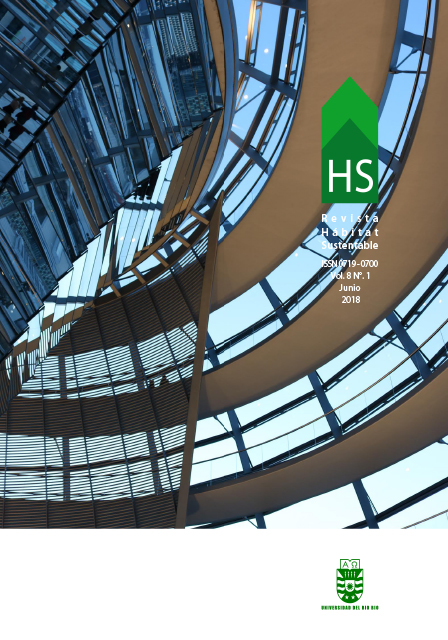Effect of natural ventilation on the energy consumption of a bioclimatic building. Analysis and study through energy plus
DOI:
https://doi.org/10.22320/07190700.2018.08.01.05Keywords:
natural ventilation, computer simulation, energy performanceAbstract
Passive cooling through natural ventilation has a great potential for single-family homes and temperate continents such as the city of Mendoza, located in the central west of the Argentine Republic. This strategy seeks to end the risks of overheating and reduces the energy consumption of mechanical conditioning equipment. This study aims to evaluate the influence on energy consumption, in two ventilation scenarios (day and night) for two constructive resolutions (light and mass). For this, a computational model of a single-family house, modeled and adjusted in the Energy Plus v8.6 program was used. For the ventilation model, “Airflow Network” (AIRNET algorithm) validated by Gu (2007) y Crawley et al. (2001) was used. The results indicate that, in the construction as well as in life, with night ventilation the energy consumptions are lower in 50% than they ventilate during the day. The natural ventilation in bioclimatic buildings is an indispensable strategy for the cooling of the same. In this situation lies the importance of having a simulation tool to test different scenarios of use and control of the same.
Downloads
References
BRAGER G. y BAKER L., Occupant satisfaction in mixed-mode buildings, Build. Res.Inf. 37 (4) (2009) 369–380.
RAYA I.A., NICOL J.F., MCCARTNEY K.J. y HUMPHREYS M.A.. Thermal comfort: use of controls in naturally ventilated buildings. Energy and Buildings, 33 (3) (2001), pp. 235–244
EBEL W, GROßKLOS M, KNISSEL J, LOGA T. Wohnen in Passiv- und Niedrigenergiehäusern. Eine vergleichende Analyse der Nutzerfaktoren am Beispiel der ‘Gartenhofsiedlung Lummerlund’ in Wiesbaden-Dotzheim. Energieteil des Endberichts; Bauprojekt, messtechnische Auswertung”, Institut für Wohnen und Umwelt IWU, Report, 2003. 287p.
MERCADO MV. , BAREA G. , ESTEVES A. Auditoría y simulación energética en la ciudad de mendoza, argentina. Análisis del comportamiento térmico de una vivienda unifamiliar de diseño pasivo y consumo energético anual. ASADES 2015.
HERKEL S., KNAPP U. y PFAFFEROTT J. Towards a model of user behaviour regarding the manual control of windows in office buildings. Building and Enviroment 43 (4) (2008) 588-600
EnergyPlus - Software de simulación de energía. Estados Unidos Departamento de Energía Disponible en: https://energyplus.net.
SORGATO M.J., MELO A.P., LAMBERTS R. The effect of window opening ventilation control on residential building energy consumption. Energy and Building. Elsevier. Vol 133- pag.1-16.2016.
Downloads
Published
How to Cite
Issue
Section
License
The content of articles which are published in each edition of Habitat Sustentable, is the exclusive responsibility of the author(s) and does not necessarily represent the thinking or compromise the opinion of University of the Bio-Bio.
The author(s) conserve their copyright and guarantee to the journal, the right of first publication of their work. This will simultaneously be subject to the Creative Commons Recognition License CC BY-SA, which allows others to share-copy, transform or create new materials from this work for non-commercial purposes, as long as they recognize authorship and the first publication in this journal, and its new creations are under a license with the same terms.











 Scientific Information Program/Concurso Fondos de Publicación de Revistas Científicas 2018/ Proyecto Mejoramiento de Visibilidad de Revistas UBB (Código:FP180007).
Scientific Information Program/Concurso Fondos de Publicación de Revistas Científicas 2018/ Proyecto Mejoramiento de Visibilidad de Revistas UBB (Código:FP180007).





